As previously moved the houses in Moscow
About shifting architectural structures known to many. Including the distant prehistory, when in 1455, Aristotle Fioravanti suffered a bell tower of the church of Santa Maria Madzhorne with all the bells more than 10 meters. And about the history of the domestic, as in 1812 in Morshansk local craftsman Dmitry Petrov moved the wooden church. In 1898, engineer IM Fedorovich spent shifting the two-story brick house on Kalanchevke in Moscow. In 1899, during the construction of the church in the Little Georgia Street Engineer Rosten moved two small houses.
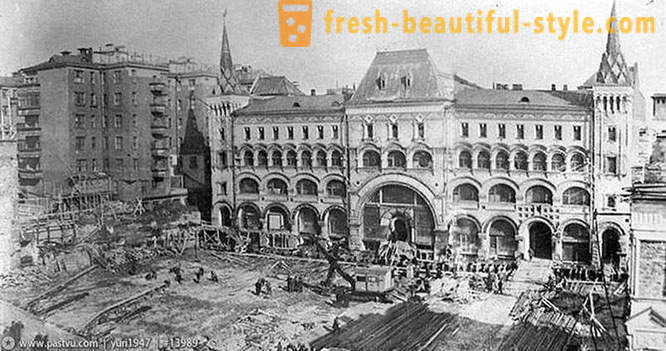
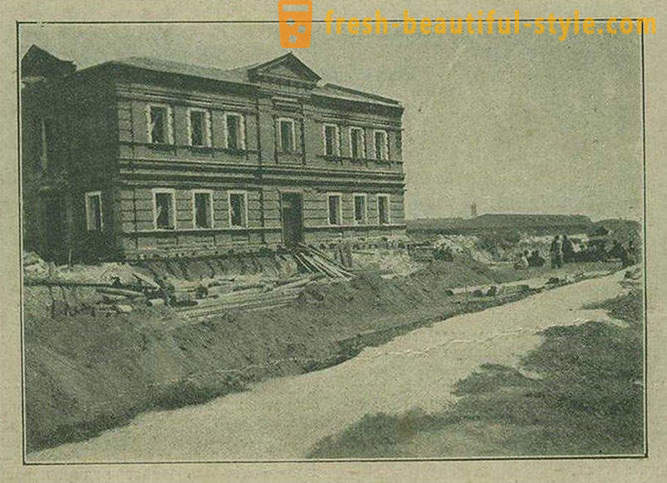
Yet shifting houses the revolution has not been widespread. This practice was resumed later, when in 1934 an engineer Kirlan moved in Makeyevka stone two-storey building mail weighing 1,300 tons. He did a pre-trial shifting of the small one-story house weighing 70 tons. One year later at the mine in Kriviy Horn moved residential building weighing 1500 tons at a distance of 240 m.
The Moscow office was established in mid-1936, which passed the specialists and workers from the Metro construction, have already tested their strength in the new case. At the beginning of its activities, it traveled six small brick buildings, practicing methods of work, testing tooling, equipment.
The first brick house in the country was moved in 1897. When expanding the ways Nikolaev railway engineer of the Ministry of Railways and the employee HDD Osip Fedorovich Markovic on his own initiative, he proposed to move one of the buildings that was going to be scrapped. The owner of this two-story brick house was asked to pay for the transportation structure, which he had already sold the w / e. The owner of this strange proposal agreed. This man was, or rather was, a hereditary honorary citizen of Moscow, a noblewoman, subjects of the British Crown - EI Gil Mack (aka Jane McGill), the owner of a cement plant in Kalanchevskaya street.
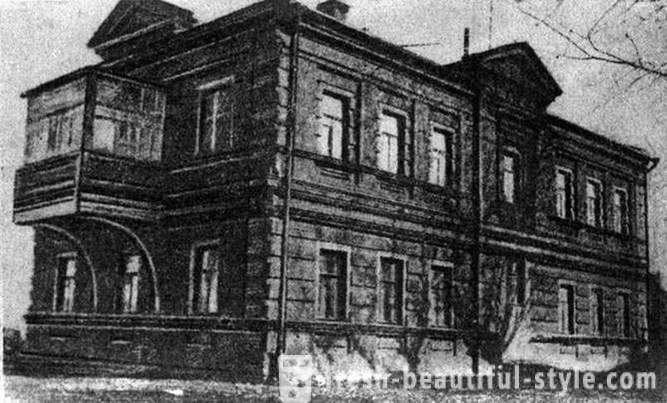
The building decided to move, based on the American experience and own developments Osip Markovic, included in the history of technology as a "method of advancing Fedorovich." The building was exempt from furnishing, demolished the oven, and then cut off the foundation, and with the help of a horse thrust the whole structure (13 to 21 meters, weighing 1840 tons) for a few days moved 100 meters to the west of the original space on a new foundation.
The building is connected in three places across the walls of iron links; in windows and doors are inserted spacers. To reduce the severity of a building plaster repulsed; removed all partitions, doors, floor and removed. At the bottom of the foundation walls of the building in all punched holes in which are inserted into the rails, interconnected joints and generally forming a stationary frame. Planted under the frame are rollers, and using jacks and winches (pulleys) building will move further in the area, which is composed of a rail for 20 yards.
A serious obstacle when moving is located on the road ditch. The moat that had to fall asleep, which took a lot of effort, since it was necessary to bring the area to fall asleep in such a state that it can not file under the pressure of gravity of the house, reaching 100,000 pounds. Work on moving house about 100 people, and is allocated on the subject of 4000 p. When the house is crossed to his place, he will be picked up and put on a prepared foundation.

This shifting has brought fame not only Fedorovich, but was advertising enterprise Mac Gill. Earned money Evgenia spent on charity.
In January 1937 he was moved lab records in Aprelevka plant house a weight of only 690 tons. It was followed by five small buildings, hindered straightening the bed of the Moscow River near the Serebryany Bor. Here office specialists mastered the challenging tracks moving buildings - a change of direction reversals. For the first time these works have used hydraulic jacks, which are associated with a curious history. Shifting occurs in winter, and jacks poured cheap denatured alcohol, which is quite low freezing temperature. As is known, the channel construction and waterworks prisoners worked, not only political, but also criminals. On the first night, despite the enhanced security and strict regime meth drained from all the jacks. I had to fill their expensive glycerin. The first phase of the new office was successful, and it was transformed into a Trust for shifting and disassembly of buildings, control of which was appointed Ivan T. Ivanov.
And the first major test was the shifting of the house №77 on the street Osipenko (currently Sadovnicheskaya Str.) On the corner of Lower Krasnokholmskaya. It was L-shaped building in the plan, "leg" which was in the middle of the new Congress Krasnokholmsky bridge. It was decided to divide the house into two parts. Short left in place, and a long (88 m) to move and expand to 19 degrees. The building was new, built in 1929, but its structural rigidity is poor; In addition, the building itself was on the waterlogged soil, in the former floodplain. Nevertheless, the chief engineer of the trust EM Handel decided to move house.
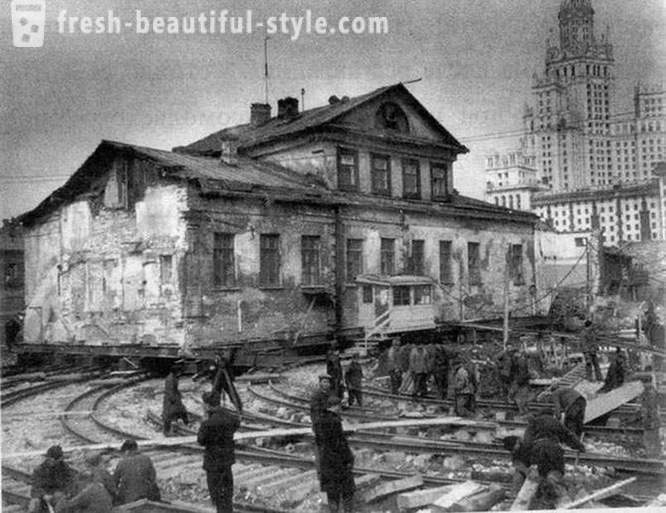
Site Manager, who commissioned the work, experienced practical engineer, wrote a memorandum in Moscow City Council Housing Department, in which he called shifting in such circumstances adventure. But Handel stood his ground, the other experts supported him, and the chief of the site had to resign. House to move without the relocation of people; We worked all engineering systems of the building: electrical supply, water supply, sewerage, telephone. Shifting has ended successfully. A similar situation exists in the construction of the Big Stone Bridge - interfered house №5 / 6 on the street Serafimovich, the same one that is immortalized in a poem by A. Barto. Conditions, however, were better, although the ground is also unreliable, but the house was built solidly. Feature here was the need to lift the building (weight 7500 tons) at a height of 1, 87 m. Pulling also occurred without evacuation of residents. Next shifting was a serious test for the whole team of the trust. When the implementation of the Master Plan for Reconstruction of Moscow turned out that many of the houses in favor of the "red line." Some of the houses destroyed, but some survived. Residents of the house №24 on Gorky Street (formerly Savvinskaya Compound) learn that their house be demolished, wrote a letter to Bulganin, who held the chair of the Presidium of the Moscow City Council chairman with a request to keep the house. The letter fell to Khrushchev, and he, due to certain circumstances, agreed.
The difficulty lay in the fact that all previous houses were several times lighter than a house Savvinskaya monastery, weighing about 23 tons. And perhaps the decisive factor was the fact that in the United States by the mid-1930s. the largest building was displaced 8-story telephone exchange in Indianapolis, vesivshaya "only" 11 thousand tons. How can we not take this opportunity to surpass America. Khrushchev approved the initiative and even personally inspected scheduled to shifting house. He has put forward only one condition: the end of the operation in March 1938, Time was running out. And the next day the training, which lasted more than four months. In the basement, knocking hammers. According to the cut-off at home with the foundation have been punched, "track", which brought in the powerful beam dvuhtavrovye subsequently welded together. Thus, the house was in a sturdy steel frame.
At the same time we prepared the territory for which the planned journey home; the basement was filled with rubble, to establish there the rails. When these works were carried out, the walls began to punch slots (holes), which then turned into a long corridor under the house. Initially struck 12 such corridors. They sleepers laid on a solid concrete base, and then the rail tracks. After that, the steel rollers along the rails were laid dvuhtavrovye driving beams, which are welded to the steel frame. The house was already standing on the part of the steel rollers, and part on the foundation. Then cut a further 12 corridors and the operation repeated. Once punched a third of all the corridors, the house was removed from the basement, and it turned out to be 2100 rollers. Not far from the house is Ikonnikova possession №77, where more complex movement of the house has been made. Article from the book "The House moved" 1998 edition: "... Everything in life is relative, and even real estate can be driven. Houses began to move more than 500 years ago. By this time in Moscow Moved almost 70 different weights and shapes of houses. One of the first and most difficult peredvizhek perfected the summer of 1938 in the horticultural island. Long apartment building stood across the course of building a new bridge Krasnokholmsky. It was decided to cut off a part of the house and move, expanding its (part) parallel to the highway bridge under construction. "

It is difficult to imagine today. People live in the house, and every day he goes somewhere, fantastic! 1959.

The residential house №77 length of 88 meters in Sadovnicheskaya street was built in 1929. In 1937, in connection with the reconstruction of the Moscow bridge, it was decided to half of the house (44 meters in length and weighing 8,500 tons) and cut it to move at an angle of 19 degrees to a new foundation. 37 on train tracks home without eviction during the week moved. Due to the fragility of island bases trolley left in the basement, not removing them after the surgery done.
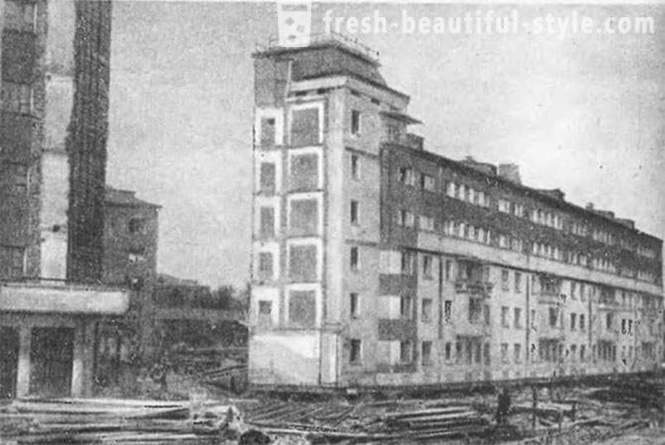
advancing over. Here you see a house in a new place. During 103 hours the right wing of the building was moved by 53 m 19 cm, left -. 33 m 72 cm "Transition" is completed successfully. Observers have found in the house of any deformations.
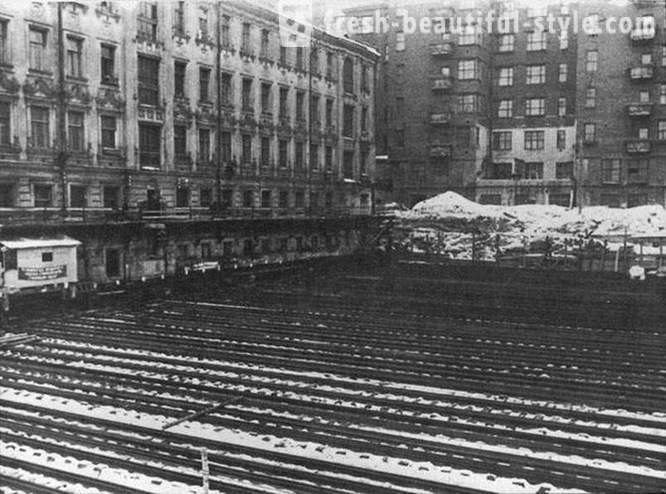
shifting Savvinskaya monastery on Tverskaya (Gorky) Street (ex. Building 24, now in the courtyard of the house 6).
After laying the track 36, and jack mounting winches house I was ready for shifting. Tenants, knowing that their home is moved, worried and asked to warn about the beginning of the shifting in time to move in with relatives. But they pointed out false deadlines and, as later recalled E. Hendel, head of works, this was done deliberately. At night, March 4, 1939 2 hours 03 minutes 20-ton winch gently lifted the house and rolled it to a new location.

On the other hand
Water supply, sewerage, electricity, telephone, radio and other communications were attached to the building by means of flexible temporary connections. House really move very slowly, and many residents have learned about it only in the morning. In one of the apartments for a six-year girl Inna Rozanov on the eve of playing with blocks and built a tower of them. Tune up, she went to sleep, leaving the tower on the table. The next morning towers survived, not scattered. Shifting finished in three days, moving the house 49 m 86 cm. Now he was standing in the courtyard of the house №6 of Tver. As a rule, advancing all communications are working properly, but after you connect them to the fixed network started interruptions. Residents displaced Sadovnicheskaya house on the street reported bitterly in 1939 that after a year and a half after the shifting of the house and is not connected to the gas network.
It should be noted that this house does not carry. Even when they were building the house, and erected it on a swamp, filled with sand, there was a lot of trouble. Do not have time to lay the foundation, he began to settle and fall. Scored powerful piles, navezli many more cubic meters of earth, but then went to the construction of the great adventure.
(In 1967, on the eve of the November holidays (?) *, Where the explosion occurred. The tragedy happened in the late evening, when Muscovites calmly went to bed. From all over the city rushed ambulances, which, plunging the wounded were being carried away with a howl. their place is immediately occupied by others. Scary conveyor worked methodically and quietly, without fuss and cry. the smoke from the fire that was quenched with dozens of fire engines, mixed with the steam from the hot water heating, which still could not block, and shrouded the entire district. Teens indicted We worked not only rescue, . Yedike and fire Entire battalions of sappers, one after another, with his bare hands assorted debris Later came a powerful technique -. Cranes, bulldozers, dump trucks ... - In the basement of the house, between the building and the foundation still maintained strong metal frame, on which the house is moved, - says Alexei Bardash, a civil engineer from the Institute of Advanced Training of civil servants. - Imagine how much metal did not spare time, in the 30s, when it was very necessary for the country! Rama put on rollers and concreted site moved to a new house. Tenants is not evicted.

At the base of the house is still walled trolley, on which he rode to a housewarming party for 150 meters towards.
After moving to the gap between the two parts of the house parted built 6-storey box. And the people continued to live here until the '60s, until the explosion occurred. According to one version, blame natural gas, on the other - under the house there was a fracture of the cortex. Part of the house spreads, many of the wounded were taken to hospitals, and the remaining residents gradually resettled. Some years the house was dilapidated, and then it was given to the offices and institutions. The letter T was only moved a long leg, the rest could not be reconstructed. And now the end of the building is interrupted - no flat wall, and a strange polygon. After almost 70 years after moving Auca its effects: moving the building, part of it for some reason put on the pile, and some - not. Because of this, the house settles unevenly, in the walls of cracks, and recently recognized its subject to demolition).

The building of the Moscow City Council. It not only moved deep into the quarter, but also to build on. Who is the mayor's office.
We prepared thoroughly and responsibly, because it was not an ordinary building. But not without the influence of ideological structures and were able to set a record here. After all, it was necessary to outdo America. Before engineers preset task - to move the house, along with people. But more than that, it was in favor so-called Stakhanov movement. And high-speed techniques were introduced everywhere, indiscriminately - whether it's coal mining or growing cows, build houses or student learning. Stakhanov method applied to the shifting and buildings, and without taking into account the technical characteristics. But in the case of the Moscow City Council, this method was the most dangerous. The old building, built MF Kazakov, was delivered "peace" that is in the form of letter P, and the load on the front of the building while driving is distributed unevenly. In addition, the house has a large double-height hall, that is a huge space without rigid walls, and in the case of the slightest imbalance could emerge as a house of cards, and together with the people.
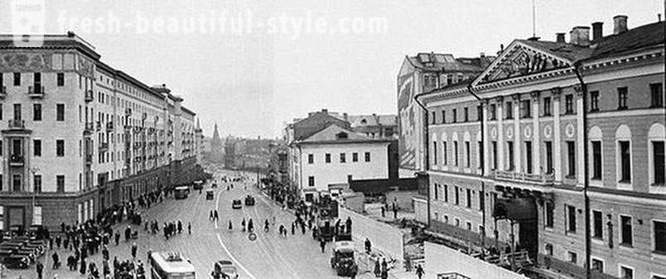
Cautious Americans used to peredvizhek even simple manual mechanisms of buildings, in the extreme case of horses, and moved the building at a low speed. Our engineers are, of course, foreseeing all possible consequences, could not object to the Party leadership, but still have taken some measures to allow at least a little to protect themselves from accidents. The main pulling power were two winches. At the initial stage, they were helped by 25 jacks. drum rotation speed winches regulated, and it can be easily reduced. In addition to the plurality of telephone outlets, which it was easy to connect (not yet invented when cordless phones), on the whole route there were dozens of emergency buttons that allow you to instantly stop the shifting. On the whole engineering staff of the trust he was involved. With a huge crowd of people moved to the building of 13 to 65 m for 41 minutes. Record set. However, in the walls and ceilings of any deformation, cracks. Later, when the superstructure and reconstruction had to be embedded in the building 24 metal columns.
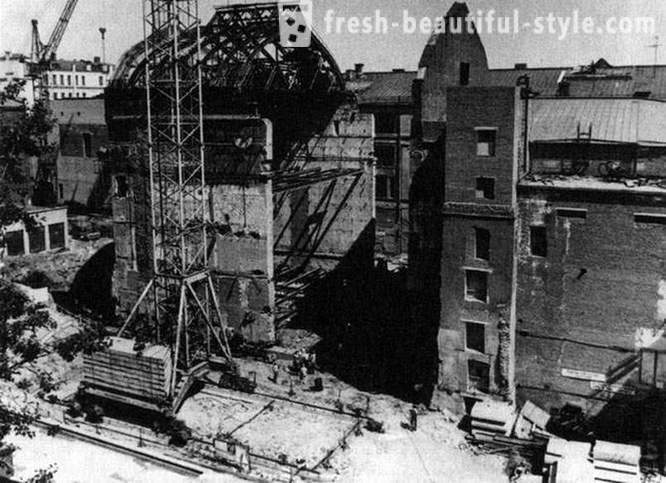
Before the war, we moved 22 stone buildings and dozens of wooden. In the post-war system of values has changed. Even the historical monuments declared "low-value building" and let a bulldozer or burned. Nevertheless, a long time ago it fired several peredvizhek, including unique. Among them are shifting house №24 on Lyusinovskoy street. In fact, under this number several buildings were located. It was not so heavy "monsters" in the city center. But one of the buildings was built on a more ancient, vaulted chamber, almost grown into the ground. It also decided to move. For this it was necessary to tear deep trench the entire length of the shifting - 42 meters. The work lasted for several months. No less interesting was shifting in the Chamberlain lane. When reconstructing the Moscow Art Theater in the early 1980s. old building divided vertically along line theater curtain. Theatrical box moved away from the auditorium and in the resulting gap put new walls. Thus, the theater building was extended into the interior of the quarter, keeping the main parts. But the estimated 12-foot space was too small to carry out installation work. I would have to give up the building of mechanisms and use only manual labor (and the height of the walls reached 33 meters). Therefore, the stage box initially pushed back by 24, 7 m, and then returned back to the 11, 9 m. The shifting of the reconstruction of the Moscow Art Theater in 1983, was the last. When the restructuring and change it in the era of democratic reform was not to peredvizhek. And although the country is destroyed, Moscow was built. It is not always clear how or why. Value to move 33 meters Sytinsky mansion on Tverskaya Street to put in its place another poor "Plywood" supermarket. And it is in the city center!
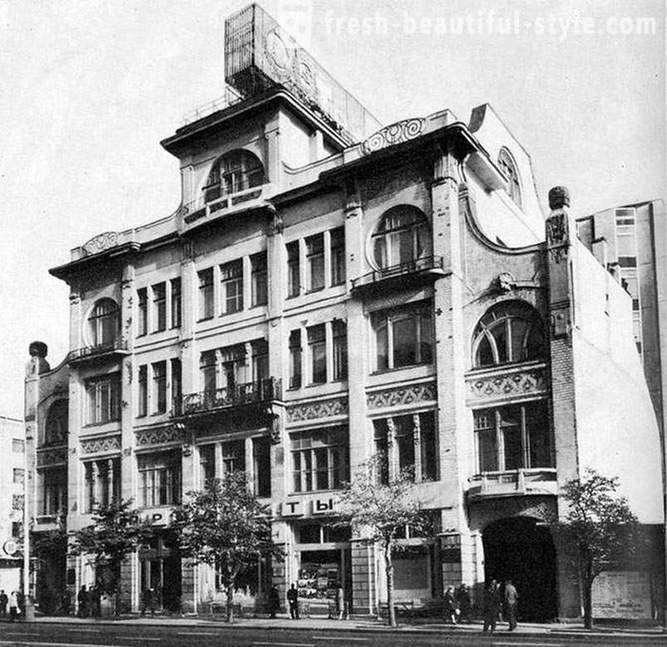
It was currently at Pushkin House, nobody touched. But in 79 it was decided to move.
Shifting Sytina home. The issue of "Trud" newspaper from 11.04.79 correspondent Viktoria Tolstoy in the report "The house went on a journey," reported the details of the event: "At five in the morning, just as dawn was planned over the city, the final preparations and given command to start the compressors have been completed. Arrows on the instruments showed the force of 170 tons. Powerful shiny cylinders four jacks ran into a steel beam on which rested ready for shifting house, and he slowly rolled along the rails along the main streets of Moscow. With the speed of the second hand spinning thick steel rollers, and almost imperceptible eye building Mahina swam toward Mayakovsky Square. "
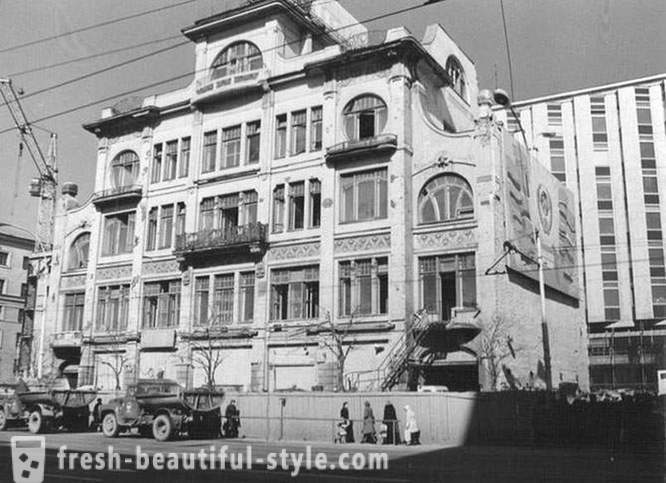
33 m with a small building broke three days and joined under construction while the conference room "Izvestia" newspaper office. Pushkin Square in front of the subway immediately became freer. 1979.
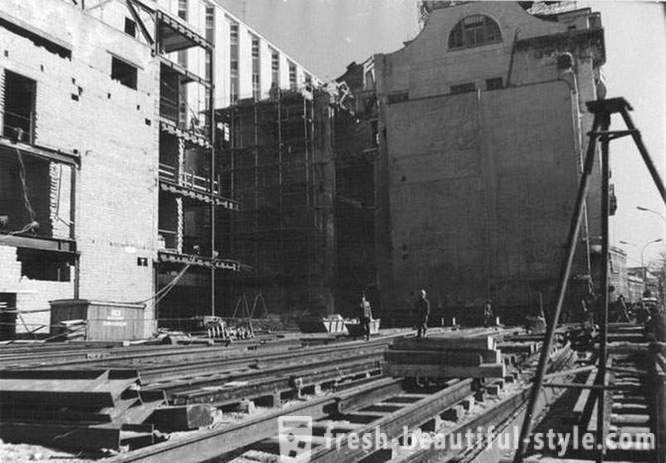
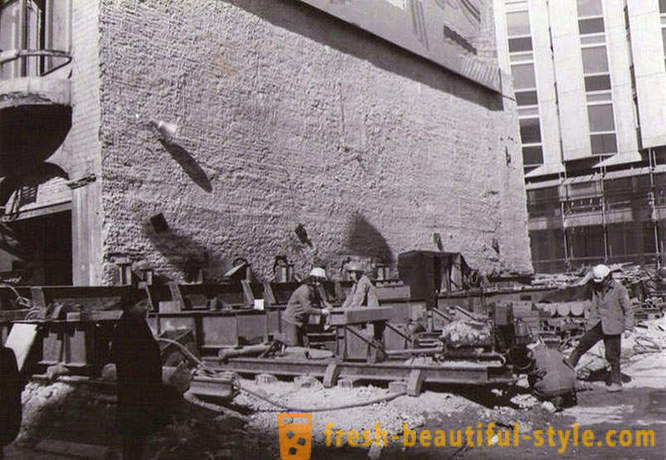

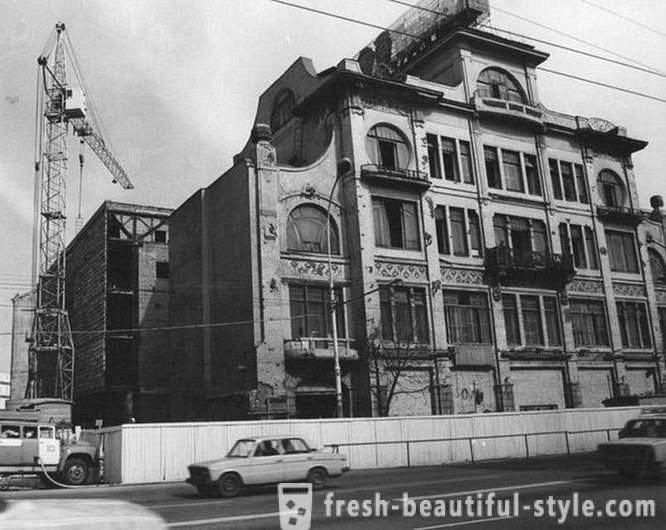
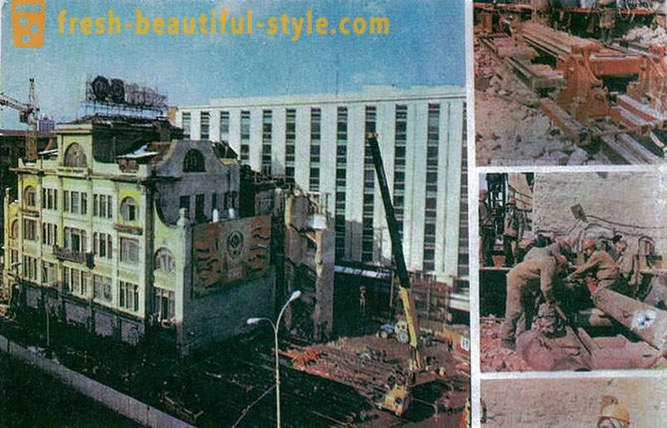

Besides moved houses and monuments. Here in 1950, he goes to a new place of Pushkin.

"They were overcome by uneasiness, wanderlust (very painful property, few voluntary cross)" (Pushkin, "Eugene Onegin").
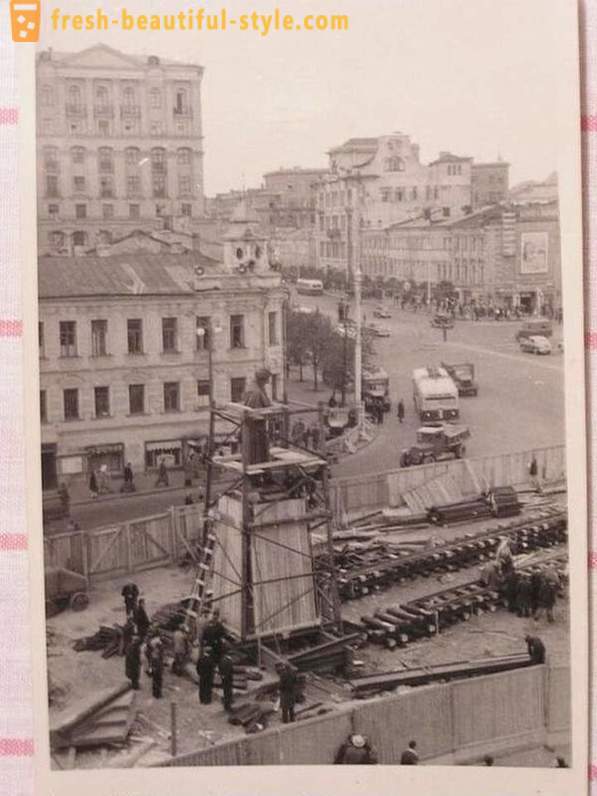
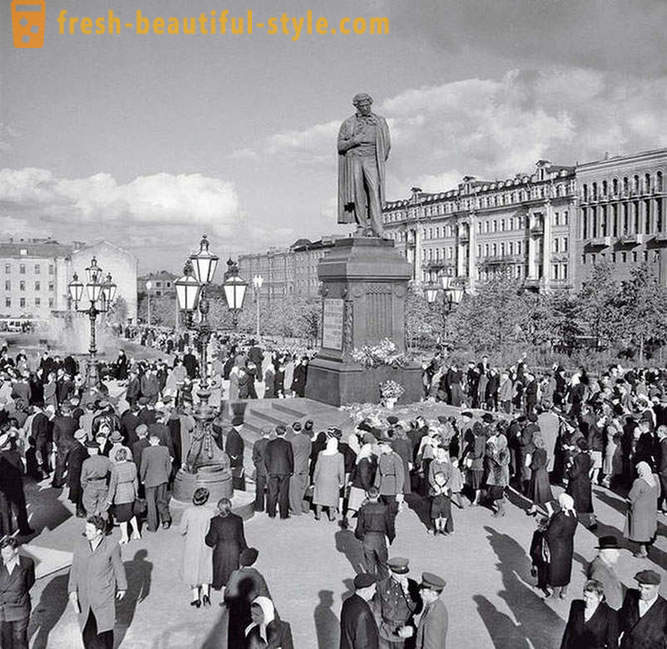
At the new place
Since then - almost 30 years - at home in Moscow did not "walk".
"All the technologies that have come up with our engineers, are now widely used abroad", - says the director of "Architect" Catherine Chugunova. For example, the Germans are not afraid to be transferred to a new place of ancient churches. In the homeland of the development that were formed over decades are not used - the building easier to demolish and build "the same", instead of pushing it "to move."
A short video about how to move the house:













































